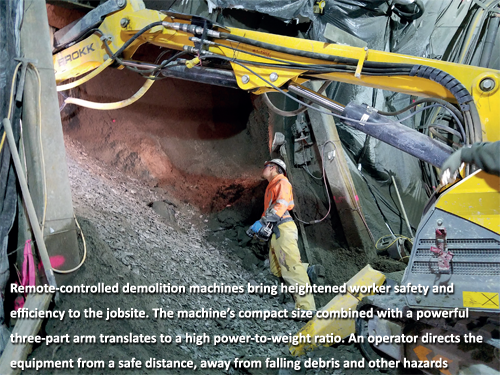Robotic tunnelling
Improving tunneling safety and productivity with remote-controlled machines. By Mike Martin and Keith Armishaw
The tunneling industry, like construction overall, is constantly evolving with new innovations to improve speed, safety and quality of work. From advancements in tunneling equipment to new methods of completing old processes, it’s in a contractor’s best interest to stay informed of potentially profit-boosting developments.
Many contractors have found success with remote-controlled machines in a number of underground applications. These machines offer significant safety and productivity benefits over traditional methods — often removing the need for four to five person crews with hand tools — and allowing contractors to better utilize their workforce. A range of attachments and overall versatility also increase growth potential for owners, enabling them to tackle excavation, cleaning and more in tunnels and pipes from five to 30 feet in diameter.
Here’s how.
Remote-controlled demolition robots
Remote-controlled demolition machines bring heightened worker safety and efficiency to the jobsite. The machine’s compact size combined with a powerful three-part arm translates to a high power-to-weight ratio — much greater than any excavator in the same weight class. An operator remotely directs the equipment from a safe distance, away from falling debris and other hazards.
Contractors use the robots in developing tunnels or expanding existing tunnels. One consistent tunnel application is the development of cross passages between parallel tunnels. Here, the robotic three-part boom allows for less overhead  clearance and provides a far more productive solution. Traditionally, a standard excavator couldn’t get to these tight spaces or, if it could, took up a lot of valuable work space, restricting movement and access. This led contractors to rely on more manual methods, such as laborers with handheld tools. The compact size of remote-controlled machines, however, provides a hard-hitting mechanical solution that results in significant time savings. A tunneling contractor working on a massive Sound Transit Link Light Rail expansion project saw this in 2017, completing multiple cross passages a week faster than they would have with handheld tools and mini excavators.
clearance and provides a far more productive solution. Traditionally, a standard excavator couldn’t get to these tight spaces or, if it could, took up a lot of valuable work space, restricting movement and access. This led contractors to rely on more manual methods, such as laborers with handheld tools. The compact size of remote-controlled machines, however, provides a hard-hitting mechanical solution that results in significant time savings. A tunneling contractor working on a massive Sound Transit Link Light Rail expansion project saw this in 2017, completing multiple cross passages a week faster than they would have with handheld tools and mini excavators.
Additionally, the remote-controlled machines excel at multiple tasks during the cross passage construction process, increasing versatility and productivity. Contractors use a variety of optional tools to excavate the cross passage while keeping workers out of harm’s way. In addition to buckets, breakers and drum cutters, this can include using a rock drill attachment to drill holes for well points, spiles or for ground freezing. Then, an operator uses the machine with a breaker attachment to bust through the tunnel’s concrete wall. Once through, contractors use the machine to excavate the cross passage, with the benefit of keeping workers away from the unsecured cross passage face.
Hydrodemolition robots
Hydrodemolition robots are another remote-controlled type of equipment that offers improved results during tunneling projects. Often used in rehabilitation applications, the robots use high pressure water from 15,000 to 40,000 psi to remove loose or deteriorated concrete from tunnel walls, later to be replaced with fresh, strong material. Additionally, contractors use the machines for light material removal or surface preparation.
The robots are valuable for use in tunnel cleaning or maintenance work. This includes road, train, subway, pedestrian, utility, water, wastewater tunnels and penstocks, where crews typically use the equipment to remove old, damaged concrete or liners in order to prepare the surface for repair. Robots are also used for mining applications, such repairing the shaft for the elevator.
Depending on the application, contractors may optimize the robots further by pairing them with tunneling-specific attachments to improve consistency and quality. One type of accessory provides operators the ability to remove 360 degrees of concrete from a tunnel’s inner wall. Contractors attach the robot’s cutting head to the end of the attachment, which rotates and moves the water jets along the circumference of the wall. The robot then moves forward to the next section of concrete to repeat the process. Unlike traditional methods, such as handheld breakers or hand lances, the cutting head of the Hydrodemolition robot stays an even distance away from the surface, allowing for an even depth of material removal throughout the process, even in uneven- or oval-shaped tunnels.
Tunneling innovations
Taking a new approach to tunnel development, tunnel expansion, cross passage excavation or tunnel wall concrete removal can be beneficial to contractors looking to improve project speed and quality while also reducing risk to their workers. Remote-controlled equipment doesn’t remove the worker from the equation, but it goes a long way toward ensuring they go home safely after completing a job
Mike Martin is vice president of operations for Brokk Inc, in Monroe, Washington. Brokk has been the world’s leading manufacturer of remote-controlled demolition machines and attachments for more than 40 years.
www.brokk.com
Keith Armishaw is the Aquajet business development manager in North America through Brokk Inc. Aquajet is known as the industry leader in hydrodemolition machines and solutions, both in terms of quality and volume.
www.aquajet.se